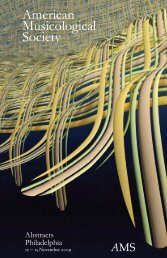Abstracts - American Musicological Society
Abstracts - American Musicological Society
Abstracts - American Musicological Society
You also want an ePaper? Increase the reach of your titles
YUMPU automatically turns print PDFs into web optimized ePapers that Google loves.
SOME NON-CONFLICTING ATTRIBUTIONS,<br />
AND SOME NEWLY ANONYMOUS COMPOSITIONS<br />
FROM THE EARLY SIXTEENTH CENTURY<br />
Stanley Boorman, New York University<br />
Saturday morning<br />
A surprisingly large number of rnadrigals frorn the<br />
first generations of composers, including Arcadelt,<br />
Festa, Verdelot and Willaert, survive rvith conflicting<br />
attributions in their various sources. The maj ority of<br />
the names are attached to the compositions in printed<br />
sources, principally the work of Gardane and the<br />
Scottos (with Antico) during the 1530s and 1540s.<br />
The manner by which the printers entered the<br />
composers' names was largely a matter of printing-house<br />
routine. The practices a11or,red for specific types of<br />
rnistake, and, when they rrere changed, allowed for<br />
misunderstanding and inconsistencies. As a result, a<br />
number of the conflicting attributions can be shown to<br />
be the probable result of printer's error, and not of a<br />
deliberate change of opinion.<br />
This paper will outline the techniques followed by<br />
the printers, in particular when three madrigals appear<br />
on an opening, and will demonstrate the rnanner in which<br />
mistakes arose; it will also indicate some forty cases<br />
in r,rhich specifie attributions nay be disregarded,<br />
involving (among other narnes) Arcadelt, Alfonso de11a<br />
Vio1a, Corteccia, Festa, Mr Jhan, Layolle , Naich, de<br />
Silva, Verdelot, Willaert and Yvo.<br />
Alfred Mann<br />
BACH<br />
Eastman School of Music Chair<br />
TUTTI-SOLO ALTERNATION IN THE<br />
CHORAL MOVEMENTS OF BACH CANTATAS<br />
Richard Benedum, University of Dayton<br />
In recent years scholars have debated the size of<br />
Bach' s chorus . Bach hirnself gives several clues , thus<br />
far largely neglected, that shed light on this issue<br />
and the related matter of solo - tutti alternation ' In<br />
six cantatas, he marks "so1o" and "tutti" alternations<br />
clearly in the perforning parts and gives occasional<br />
clues in the scores as we11. In these cantatas the<br />
following conditions accompany Bach's explicit rnarking<br />
of "so1o" or "tutti" in the vocal parts:<br />
1) orchestral forces are greatly reduced,<br />
generally to continuo a1one, when solo voices are<br />
specified.










